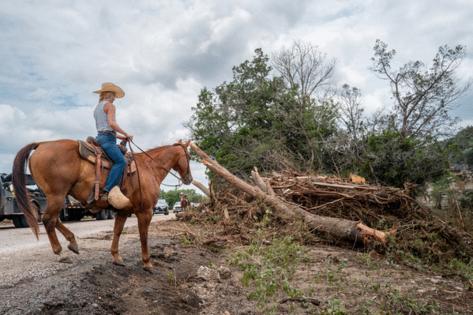No alerts heard in deadly Texas flash flood as over 160 still missing
Published in News & Features
In the early hours of July 4, the only sound many of the vacationers along the banks of the Guadalupe River would have heard was pounding rain and thunder. They didn’t get any official warning of the rapidly rising waters that ultimately proved deadly to dozens of people swept away in central Texas flash floods.
Investigators sorting through the aftermath of a natural disaster that killed more than 100 people and left more than 160 others missing are now trying to put together what happened. They’re seeking to identify when weather forecasters first advised local officials about the potential for catastrophic flooding and what those officials did to spread the message to the thousands of revelers in the area for the Fourth of July holiday weekend. Information has come out in trickles and from anecdotes, with state, county and city authorities so far insisting that their focus must be on rescue and recovery, not an analysis of what went wrong.
On Tuesday, more than four full days after the catastrophe, several reporters at a news conference pressed Kerr County Sheriff Larry Leitha to detail when local officials knew floods were an issue and whether they considered ordering an evacuation.
“That is not my priority right now,” Leitha said. Officials refused to answer a question about who was monitoring for alerts or leading emergency preparedness efforts. They wouldn’t say how many people remain missing, and have no estimate of the number of people who were in the area at the time the floods struck.
What’s known for certain is that the area had a history of deadly deluges and was known locally as “Flash Flood Alley.” It lacked public alarms or warning sirens, partly due to the expense required to set them up, that could have woken people up overnight and sent them to higher ground. Weather alerts were sent to mobile phones in the area, but service is spotty in a largely rural region. Wi-Fi connections that would normally have provided a backup also failed as much of the area lost power amid torrential rains.
Leitha said his team is focused on recovery operations and still putting together a timeline of what happened.
Governor Greg Abbott said there are 161 people missing in the aftermath of the floods and that number may rise further as more reports come in.
“There very likely could be more added to that list,” he told reporters Tuesday.
The questions about what went wrong are growing in intensity as search crews slogged through thick mud and debris, looking for victims and holding out hope for more survivors, though no one has been found alive since Friday. Officials described the work as mentally and physically grueling, with unstable debris piles and high water complicating recovery efforts along the Guadalupe River.
In total, 109 people have been confirmed dead across the state, and authorities say the toll is expected to rise. The victims include 27 campers and counselors from Camp Mystic, a girls summer camp.
Survivors told news outlets they were awakened by barking dogs, the glare of flashing rescue lights, or the pounding storm that kept them tossing and turning through the night. Some stepped out of bed into cold water on the floor or were jolted awake by neighbors pounding on doors.
In the immediate aftermath of the floods, state and local officials had suggested that the National Weather Service’s forecasts didn’t match the severity of the situation, leaving them ill prepared to act. And indeed, while some of the service’s bulletins warned of extreme rain, the actual downpour in some places was even worse.
But the agency briefed regional emergency managers about the risks the day before the disaster and issued several warnings during the course of July 3, saying heavy rain and floods were likely. At 6:22 p.m. that day, an advisory went out that rain would drop at 3 inches per hour or more. Flash flood warnings for Bandera County went out at 11:41 p.m. Kerr County, the epicenter of the disaster, got a warning at 1:14 a.m. July 4 from the weather service. These bulletins advised of “catastrophic” flooding.
The weather service said automatic wireless emergency alerts were sent to enabled mobile devices and were also broadcast on NOAA Weather Radio. The National Weather Service’s Office of Dissemination said all alerts were sent via the Integrated Public Alert Warning System and there were no reports of transmission failures.
Kerrville City Manager Dalton Rice said on the morning of July 4 he was out jogging along the river at around 3 a.m., after the weather service had sent out alerts, and didn’t notice a significant rise in the river at that point. He also said he didn’t call for evacuations because he feared people fleeing would be trapped by rising waters and it would create traffic chaos.
First responders were out by 3:30 a.m., and even with swift-water training at least one got swept off the road, he said. “It’s very challenging,” Dalton told reporters on Monday. “We want to make sure that we activate at the right time.”
Federal officials will look into if more warnings could have been provided, Homeland Security Secretary Kristi Noem said at a weekend briefing. At the same event, she also said “we have had assets here on the ground, since the beginning of this crisis started since this weather event did start and even before it came we were alerted.”
The preparedness of the National Weather Service and its parent agency NOAA has been under scrutiny since President Donald Trump took office. Retirements and other departures have left the weather service’s two Texas locations understaffed, though both had extra workers on site in the lead-up to the flooding because of the potential for an emergency.
“All forecasts and warnings were issued in a timely manner,” a press official said in response to questions.
Questions about what went wrong have focused on the lack of a public warning system for floods like the type used on other rivers in the U.S. Proposals had been considered in Kerr County and other parts of the Texas Hill Country given a history of deadly floods, including deaths at a youth camp in the 1980s, but they were deemed too expensive.
Kerr County Judge Rob Kelly told the New York Times that local residents whose taxes would fund the system balked at the cost. “Taxpayers won’t pay for it,” Kelly told the Times.
Since the disaster, Abbott said there will be a special session of the Texas legislature to take up the issue of river warning systems. Lieutenant Governor Dan Patrick said the state would find a way to pay for natural-disaster alarm systems for the area. AccuWeather estimated the disaster may have caused $18 billion to $22 billion in economic losses and property damage statewide.
“The state will provide emergency warnings sirens where needed,” Patrick’s office said in a statement. The lieutenant governor “is completely supportive and is confident there will be strong support in the legislature.”
Texas is especially prone to natural catastrophes. It is a large state with a diverse climate that ranges from humid swamps to arid deserts. The distance between Texarkana in the east and El Paso in the west is almost 731 miles (1,175 kilometers), or more than the span between Chicago and New York City.
In the past decade, Texas has been in the top 10 states for weather-related economic losses, topping the list three times in 2015, 2017, and 2019, and coming second in 2016, 2022, and 2023, according to National Weather Service records. From 2015 to 2024, 654 people have died as a direct result of weather. Texas accounts for 31% of all damages caused by extreme weather in the U.S. during the last 10 years.
_____
(With assistance from Dave Merrill and Cedric Sam.)
_____
©2025 Bloomberg L.P. Visit bloomberg.com. Distributed by Tribune Content Agency, LLC.







Comments